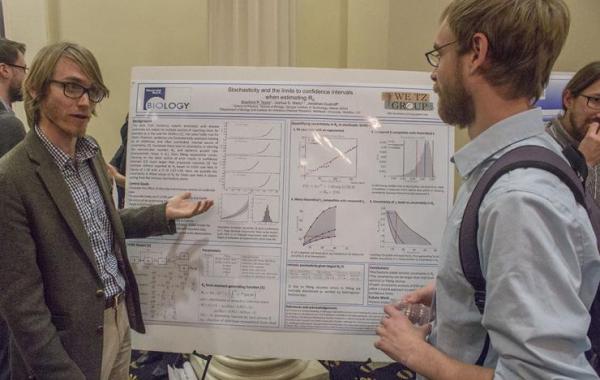Georgia Tech Gathers Experts to Improve Ebola Modeling and Response

Ebola Workshop
In the past year, more than 21,000 individuals have been infected with Ebola virus disease in West Africa and more than 8,000 are reported to have died. The outbreak response is one of the largest and most complex that the CDC and global health community have conducted. Although the outbreak seems to be turning around, there is an ongoing need for intervention and monitoring to reduce the new case count to zero.
This past week the Georgia Institute of Technology hosted a two-day workshop, "Modeling the Spread and Control of Ebola in West Africa," with more than 180 participants to discuss the use of dynamical models to support, interpret and enhance public health practices to help stop the spread of the disease.
"There is a growing coalition of modelers working at different scales - from how the disease is transmitted at the community level, to how the virus is evolving - who can contribute to support the response effort on the ground," said Joshua Weitz, chair of the organizing committee and associate professor in Georgia Tech's School of Biology.
The lectures and discussions focused on four major questions: How much confidence should we have in forecasts of the epidemic? How do we evaluate control strategies? What are the challenges in implementing these strategies? How do we communicate models to each other, public health scientists and to the broader community?
Participants in the workshop came from universities in the United States, Canada and England, as well as from the Centers for Disease Control and Prevention (CDC), the White House Office of Science Technology and Policy, the Biomedical Advanced Research and Development Authority, the Red Cross, Intel, IBM and the United States national laboratories. Speakers and panelists represented a wide array of professions and backgrounds.
Ebola is particularly tricky to model, said one speaker, because "this Ebola outbreak has not developed in the way that past outbreaks have evolved, that means we've not been able to rely on past experiences to map out our response this time around."
Epidemiological modeling, including forecasting and evaluating control strategies, is vital to the success of the response. Initially, models of Ebola spread had high degrees of uncertainty regarding the potential scope of the outbreak. This uncertainty stemmed, in part, from the lack of detailed case data and chains of transmission. Models were also poorly informed with respect to the relative importance of urban and rural transmission. Models did not have accurate estimates of the extent and speed at which safe burials would become widespread and Ebola treatment units would be built. Changes in behavior and widespread interventions are necessary to avert worst-case scenarios.
The challenge in linking models to case data are many. Much of the data needed is gathered by public health professionals and doctors, many of whom are responding to patients and working to slow the spread of the disease. Multiple panelists pointed out the need to identify data collection protocols that could serve to inform predictive models while balancing the need to respond to those they are sent to aid.
There were many other challenges to modeling the effectiveness of control efforts. Logistical challenges included traveling along roads in Africa, the transmission of Ebola from animals to humans, as well as the complications of dealing with a number of governments and scientists with different ideas of how to respond and what data to share. Communication was considered essential to move from model predictions to policies that could support an effective response.
The final panel addressed this issue by considering communication of models amongst three sectors: government, academia and the media. Experts in modeling are not usually trained to communicate with policy makers. This can lead to miscommunication, or a lack of communication. Translating scientists' results to the public and to policy makers is key. For example, communicating the need for safe burials helped to reduce the transmission of Ebola during burial ceremonies. Informing policy makers of the risks of inaction helped to galvanize support for a much larger response effort in Fall 2014.
Despite the challenges, there is some room for optimism. New cases of Ebola virus disease have dropped in the past month, particularly in Liberia. The reasons are many, including changes in behavior and the impact of interventions. Individuals with Ebola are not infectious until symptomatic, which facilitates contact tracing and leads many to believe that a successful public health response is possible. New Ebola vaccines have also been developed to be utilized in Phase II trials planned by the CDC for testing in West Africa in the coming months. Vaccine trial design was the topic of an extended breakout discussion and panel talk.
"The modeling community has work to do," remarked Weitz at the close of the meeting. "This workshop has helped to identify many scientific and engineering challenges necessary to understand how the virus spread to so many people (unlike past Ebola outbreaks), how to enact a more effective response to the ongoing epidemic and how to prevent future epidemics."
